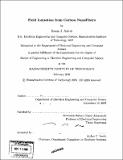Field ionization from carbon nanofibers
Author(s)
Adeoti, Bosun J
DownloadFull printable version (18.31Mb)
Other Contributors
Massachusetts Institute of Technology. Dept. of Electrical Engineering and Computer Science.
Advisor
Akintunde Ibitayo (Tayo) Akinwande.
Terms of use
Metadata
Show full item recordAbstract
The Micro Gas Analyzer project aims to develop power-efficient, high resolution, high sensitivity, portable and real-time gas sensors. We developed a field ionizer array based on gated CNTs. Arrays of CNTs are used because of their small tip radii and high aspect ratio which yields high electric fields at low voltages. One possible configuration for the device is to bias the CNTs at the highest potential, and the collector or anode at the lowest potential. In this configuration, the electrons in the outer shell of the molecules tunnel out due to the high local electric fields which serve to lower the unperturbed potential barrier seen by the electrons. The tunneling effect is a purely quantum-mechanical process whose probability of occurrence is strongly dependent on the applied electric fields.We optimize the theoretical current obtainable from the Field Ionization Array (FIA) by varying structural parameters in our device. The most relevant parameters include the radius of curvature, height, base radius and base angle of the grown tip; height and thickness of the tip; and the gate aperture. Varying the gate (or oxide) height without updating the height of the CNT yields the derivable result that the electric field is maximized when the tip is at about the same height as the gate. We demonstrate field ionization of Argon from multi-walled CNTs and provide a numerical framework for analyzing the generated ion currents in cases where the surface electric fields are low.
Description
Thesis (M. Eng.)--Massachusetts Institute of Technology, Dept. of Electrical Engineering and Computer Science, 2008. Includes bibliographical references (p. 109-111).
Date issued
2008Department
Massachusetts Institute of Technology. Department of Electrical Engineering and Computer SciencePublisher
Massachusetts Institute of Technology
Keywords
Electrical Engineering and Computer Science.